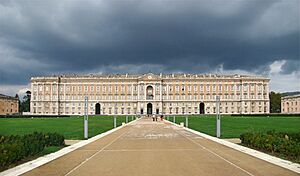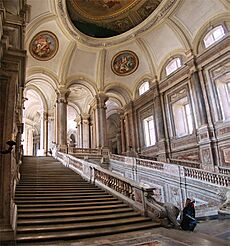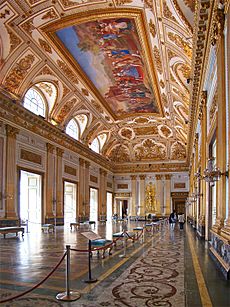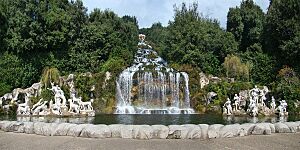Royal Palace of Caserta facts for kids
Quick facts for kids Royal Palace of Caserta |
|
|---|---|
|
Reggia di Caserta
|
|
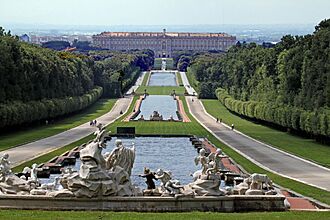
View of the northern façade from the fountain of Venus and Adonis
|
|
| Alternative names | Palazzo Reale di Caserta |
| General information | |
| Type | Palace |
| Architectural style | Late Baroque and early Neoclassical |
| Location | Caserta, Italy |
| Address | Viale Douhet, 81100 Caserta CE, Italy |
| Construction started | 1752 |
| Technical details | |
| Size | 247 × 184 × 36 meters (42 meters including the roof) |
| Floor area | c. 138,000 square metres (1,490,000 sq ft) |
| Other information | |
| Number of rooms | 1,200 |
| UNESCO World Heritage Site | |
| Part of | 18th-Century Royal Palace at Caserta with the Park, the Aqueduct of Vanvitelli, and the San Leucio Complex |
| Criteria | Cultural: (i), (ii), (iii), (iv) |
| Inscription | 1997 (21st Session) |
| Area | 87.37 ha (0.3373 sq mi) |
| Buffer zone | 110.76 ha (0.4276 sq mi) |
The Royal Palace of Caserta (in Italian: Reggia di Caserta) is a huge former royal home in Caserta, a city in southern Italy. It was built for the Bourbon kings of Naples to be their main residence. Started in the 18th century, it is the largest palace from that time period in all of Europe.
In 1997, the palace became a UNESCO World Heritage Site. UNESCO called it the last great example of Baroque art, a style known for its fancy and dramatic designs. The Royal Palace of Caserta is the largest former royal home in the world by volume. It has over 2 million cubic meters of space and covers an area of 47,000 square meters.
Contents
History of the Palace
The story of this grand palace begins in 1752. The king of Naples, Charles VII, wanted a magnificent new home for his court. He hired an architect named Luigi Vanvitelli to design it. When King Charles saw the model for the palace, he was so amazed and excited.
However, the king never actually lived in the palace. In 1759, he left Naples to become the King of Spain. The work on the palace was continued for his son, Ferdinand IV of Naples.
A Palace Inspired by Versailles
The main inspiration for the Royal Palace of Caserta was the famous Palace of Versailles in France. Like Versailles, Caserta was designed to be more than just a home. It was planned to be like a small city. It would house the king, his court, and the government.
One of the king's main goals was to build the palace in a safe place. He wanted it away from the sea, where it could be attacked, and far from the busy city of Naples. The palace even had barracks for soldiers to protect the king.
Art historian Anthony Blunt said that Caserta was a symbol of the new monarchy. He noted that while it was inspired by Versailles, it was not a copy. Caserta was designed by one architect all at once, which made it feel more unified and harmonious than Versailles.
The Palace in Later Years
Luigi Vanvitelli died in 1773 before the palace was finished. His son, Carlo, and other architects took over the project. However, the original plan, which included two large curved wings in the front, was never completed.
In 1861, Italy became a unified kingdom. Officials came to the palace to make a list of everything inside. They found an object they described as a "strange object in the shape of a guitar," which was actually a bidet, a type of bathroom fixture.
From 1923 to 1943, the palace was used as the Italian Air Force Academy. During World War II, it became the headquarters for the Allied forces in the Mediterranean. In April 1945, the palace was where German forces in Italy officially surrendered, helping to end the war in the region. The first Allied war crimes trial was also held at the palace in 1945.
The palace was damaged by bombs during the war, and many of its furnishings were stolen. The Italian government has worked hard to restore the building and its beautiful decorations.
Layout of the Palace
The palace is enormous and built in a rectangular shape, measuring 247 by 184 meters. Inside, two main arms cross to form four large courtyards.
The building has five floors and an incredible 1,200 rooms. This includes dozens of grand state apartments for official events. It also has 1,742 windows, 34 staircases, a large library, and a theater. The theater was designed to look like the famous Teatro San Carlo in Naples.
Of all the palaces inspired by Versailles, Caserta is said to be the most similar. It was designed to show the power and greatness of the Bourbon kings. One unique feature of Caserta is that above the king's main floor (the piano reale), there is another floor that is just as magnificent.
The Amazing Park and Gardens
The palace gardens are just as impressive as the building itself. The park stretches for 120 hectares and is a perfect example of a Baroque garden, with long, straight paths and amazing views.
The park begins from the back of the palace and features a long canal with beautiful fountains and waterfalls. A special aqueduct had to be built to bring enough water for all these water features.
Some of the famous fountains include:
- The Fountain of Diana and Actaeon
- The Fountain of Venus and Adonis
- The Fountain of the Dolphins
- The Fountain of Aeolus
- The Fountain of Ceres
In the 1780s, an "English Garden" was added to the park. This garden has a more natural and wild look, which was a popular style at the time.
A World Treasure
In 1997, UNESCO named the Royal Palace of Caserta a World Heritage Site. This means it is recognized as a place of special importance to all of humanity.
UNESCO praised the palace for its incredible design. It's not just a palace and a park, but a whole project that included the surrounding landscape and plans for a new town. It stands as an exceptional example of 18th-century art and architecture.
See also
 In Spanish: Palacio Real de Caserta para niños
In Spanish: Palacio Real de Caserta para niños
- Asteroid 274246 Reggiacaserta
- List of Baroque residences



